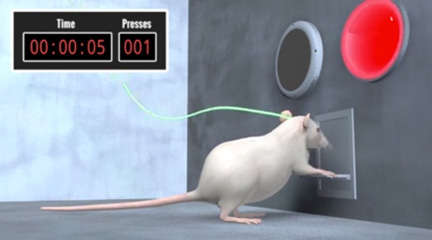This NIDA Notes animation depicts a basic experiment that researchers use to test whether a prospective new medication might help people avoid relapse to an addictive drug. In such experiments, laboratory animals make an invaluable contribution to finding new treatments for addiction.
- Transcript of video
-
Transcript
[Female voice-over]
This animation shows a basic experiment that researchers use to test whether a prospective new medication might help people avoid relapse to an addictive drug.
With this experiment, researchers rapidly screen potential medications in animals to identify those that hold promise for improving addiction treatment.
The experiment has 3 phases: Self-administration, extinction,and challenge with a cue for relapse.
Self-administration:
In this phase, a rat learns to press a lever to self-administer a drug.
It also learns to associate a cue with pressing the lever It presses the lever.
A tone sounds and a light flashes. SOUND: TONE
Simultaneously, the rat receives a dose of cocaine and feels a surge of pleasure.
The rat presses the lever again, SOUND: TONE and then again. SOUND: TONE
Each time, the rat sees the light, hears the tone, receives cocaine, and feels pleasure. SOUND: TONE
When the rat has maintained this steady tempo across several daily sessions, the self-administration phase ends. SOUND: TONES
Extinction:
In this phase, experimenters extinguish the rat's motivation to press the lever by removing the lever's connection to the drug.
The rat again finds itself in the test chamber. It presses the lever.
Nothing happens, no tone, no light, no cocaine, no pleasure.
The rat presses again and again. Gradually it learns that pressing is futile, and tapers off.
When the rat's rate of lever pressing falls to near zero, the extinction phase ends.
Challenge with a relapse cue:
In the final phase of the experiment, the researchers test whether their prospective medication will reduce the rat's response to a relapse cue.
Before starting this phase, the experimenters treat the rat with the medication.
The rat again finds itself in the test chamber. SOUND: TONE
The sound and light cue from the self-administration phase of the experiment recurs.
The rat associates the cue with the drug's pleasurable effect, and feels renewed motivation to press the lever. SOUND: TONES CONTINUE
It presses the lever repeatedly even though it receives no cocaine. SOUND: TONES CONTINUE
This renewed lever pressing parallels a person's cue-induced relapse to cocaine use.
The total number of times the rat presses the lever measures the strength of its motivation to seek the drug.
The researchers will compare the rat's lever pressing to that of another rat that has also gone through the drug self-administration and extinction phases, but now receives a placebo rather than the medication.
If the medicated rat presses the lever fewer times than the placebo-treated animal, the medication has reduced its vulnerability to the relapse cue.
A prospective medication that passes this test may be worth testing in people.
In these experiments, laboratory animals make an invaluable contribution to finding new treatments for addiction.

